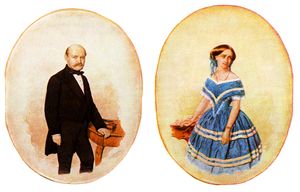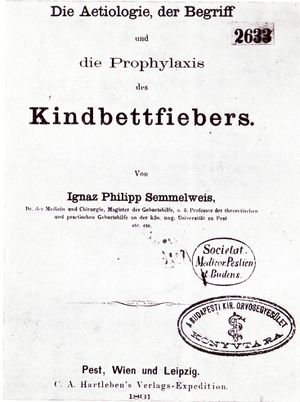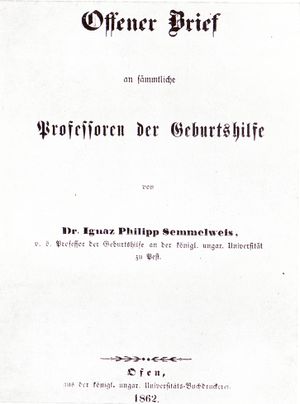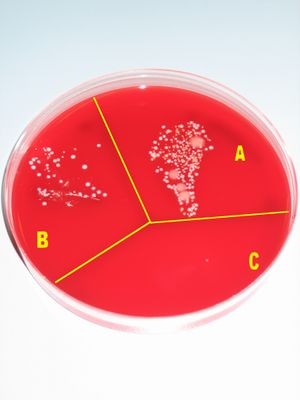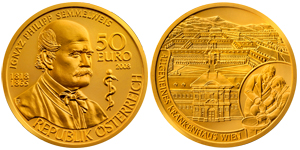إگناتس زملڤايس
إگناتس زملڤايس | |
|---|---|
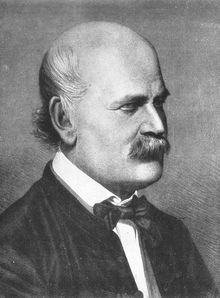 د. إگناتس زملڤايس، في عمر 42 عامًا في 1860 لوح نحاسي نقشه ينو دوبي | |
| وُلِدَ | إگناتس زملڤايس يوليو 1, 1818 |
| توفي | أغسطس 13, 1865 (aged 47) |
| الجنسية | مملكة المجر |
| المدرسة الأم | جامعة ڤيينا جامعة بوداپست |
| اللقب | إدخال معايير تطهير اليد، في طب التوليد , من 1847 |
| السيرة العلمية | |
| المجالات | طب التوليد، العمليات الجراحية |
| الزوج | ماريا ڤايدنهوفر(1837–1910) (تزوجت في 1857)[1] |
| الأنجال | أنطونيا ماريا إگناس مارگيت بيلا |
| الوالدان | يوسف زملڤايس تريز مولر |
إگناتس فيليپ زملڤايس [A] (ألمانية: [ɪˈɡnaːts ˈzɛml̩vaɪs]؛ مجرية: Semmelweis Ignác Fülöp؛ 1 يوليو 1818 - 13 أغسطس 1865)[2] كان طبيبًا مجريًا يُعرف الآن بكونه أحد الرواد الأوائل في عمليات التطهير. وقد وُصِفَ بـ "منقذ الأمهات"،[3] حيث إنه اكتشف أن حدوث حمّى النِفاس يمكن تجنبه نهائيًا عن طريق اللجوء إلى تعقيم اليدين في عيادات التوليد.[3] يشار إلى أن حمّى النِفاس كانت منتشرة في مستشفيات منتصف القرن التاسع عشر، بالإضافة إلى أنها غالبًا ما تكون مميتة، بمعدل وفيات يبلغ 10% ـ 35%. ولقد افترض زملڤايس نظرية الغسيل باستخدام محاليل الجير المكلوَر في عام 1847[3] وذلك أثناء عمله في العيادة الأولى للتوليد في مستشفى فيينا العام، حيث كان معدل الوفيات في أجنحة الأطباء ثلاثة أضعاف المعدل في أجنحة القابلات. كما نشر كتابًا عن النتائج التي حصل عليها في علم أسباب الأمراض، مفهوم حمّى النِفاس وكيفية الوقاية منها.
وبالرغم من المنشورات المتعددة للنتائج التي قلل فيها غسل اليدين معدل الوفيات لتصل لنسبة أقل من 1%، فإن ملاحظات زملڤايس تعارضت مع الآراء العلمية والطبية المقررة آنذاك، كما أن المجتمع الطبي رفض أفكاره. بالإضافة إلى أن بعض الأطباء غضبوا من اقتراح وجوب غسل أيديهم، ولم يتمكن زملڤايس من تقديم تفسيرات علمية مقبولة للنتائج التي حصل عليها. ولقد اكتسبت ممارسات سيمفليس قبولاً واسعًا بعد وفاته بسنين قليلة، عندما أثبت لويس پاستير نظرية الجرثومة، وعلى إثر ذلك قام جوزيف ليستر بممارسة ذلك وإجراء عمليات باتباع وسائل النظافة الصحية، مع تحقيق نجاحٍ عظيم. وفي عام 1865، أُحيل زملڤايس إلى مستشفى الأمراض العقلية حيث توفي هناك بسبب تسمم الدم عن عمر يناهز 47 عامًا، وكان هذا من المفارقات العجيبة.
. . . . . . . . . . . . . . . . . . . . . . . . . . . . . . . . . . . . . . . . . . . . . . . . . . . . . . . . . . . . . . . . . . . . . . . . . . . . . . . . . . . . . . . . . . . . . . . . . . . . . . . . . . . . . . . . . . . . . . . . . . . . . . . . . . . . . . . . . . . . . . . . . . . . . . . . . . . . . . . . . . . . . . . .
نظرية التسمم من الجثث
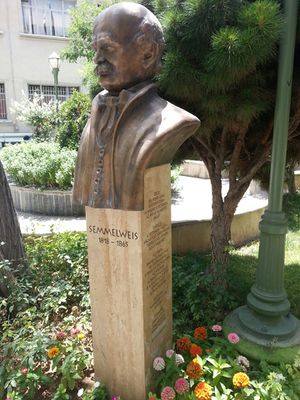
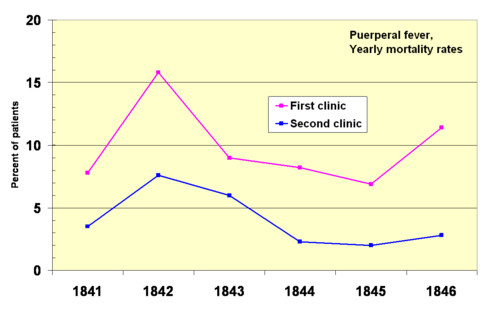
| First clinic | Second clinic | ||||||
| Year | Births | Deaths | Rate (%) | Births | Deaths | Rate (%) | |
| 1841 | 3,036 | 237 | 7.8 | 2,442 | 86 | 3.5 | |
| 1842 | 3,287 | 518 | 15.8 | 2,659 | 202 | 7.6 | |
| 1843 | 3,060 | 274 | 9.0 | 2,739 | 164 | 6.0 | |
| 1844 | 3,157 | 260 | 8.2 | 2,956 | 68 | 2.3 | |
| 1845 | 3,492 | 241 | 6.9 | 3,241 | 66 | 2.0 | |
| 1846 | 4,010 | 459 | 11.4 | 3,754 | 105 | 2.8 | |
النزاع مع الرأي الطبي المتأصل
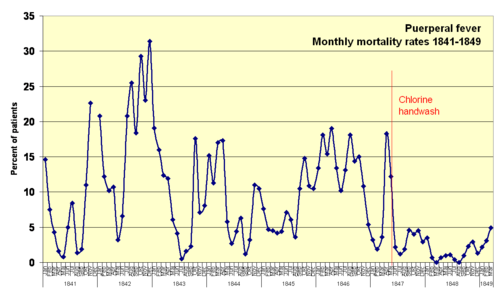
نشره النتائج بعد تردد وأولى علامات المشاكل
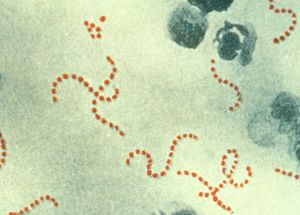
الحياة في بوداپست
رد المجتمع الطبي

الانهيار والوفاة
Beginning in 1861, Semmelweis suffered from various nervous complaints. He suffered from severe depression and became absentminded. Paintings from 1857 to 1864 show a progression of aging.[B] He turned every conversation to the topic of childbed fever.
ذكراه
انظر أيضًا
- Belief perseverance
- كارل مايرهوفر
- متحف الرعاية الصحية
- Semmelweis Frauen-Klinik
- أثر زملڤايس
- ليوپولد أوينبروگر
ملاحظات
- ^ الاسم "Semmelweis" ولكن تستخدم اللاحقة القصيرة -ڤايس، (المعنى: أسطوانة خبز- أو كعكة بيضاء). يُنطق اسم إگناتس زملڤايس، باستخدام قواعد النطق النمساوية النموذجية (اللهجة الألمانية)، هكذا "إگ ناتس ڤايس".
- ^ Paintings of Semmelweis available in the 1983 edition of his Etiology, Concept and Prophylaxis of Childbed Fever,[4] and at Wikimedia Commons.
المراجع
. . . . . . . . . . . . . . . . . . . . . . . . . . . . . . . . . . . . . . . . . . . . . . . . . . . . . . . . . . . . . . . . . . . . . . . . . . . . . . . . . . . . . . . . . . . . . . . . . . . . . . . . . . . . . . . . . . . . . . . . . . . . . . . . . . . . . . . . . . . . . . . . . . . . . . . . . . . . . . . . . . . . . . . .
الهامش
- ^ Ataman, Vatanoğlu-Lutz & Yıldırım 2013, pp. 35–39.
- ^ Semmelweis Society International: Semmelweis biography Archived 2018-01-02 at the Wayback Machine
- ^ أ ب ت خطأ استشهاد: وسم
<ref>غير صحيح؛ لا نص تم توفيره للمراجع المسماةHanninen1 - ^ Semmelweis 1983, p. 57.
=أعمال مذكورة
- Antall, József; Szebellédy, Géza (1973), Aus den Jahrhunderten der Heilkunde, Budapest: Corvina Verlag, pp. 7–8
- Ataman, A. D.; Vatanoğlu-Lutz, E. E.; Yıldırım, G (2013). "Medicine in stamps-Ignaz Semmelweis and Puerperal Fever". Journal of the Turkish German Gynecological Association. US National Library of Medicine. 14 (1): 35–39. doi:10.5152/jtgga.2013.08. PMC 3881728. PMID 24592068.
{{cite journal}}: Invalid|ref=harv(help) - Benedek, István (1983), Ignaz Phillip Semmelweis 1818–1865, Druckerei Kner, Gyomaendrőd, Hungary: Corvina Kiadó (Translated from Hungarian to German by Brigitte Engel), ISBN 963-13-1459-6
- Braun, Carl (1857), Lehrbuch der Geburtshülfe, Vienna, Austria: Braumüller
- Breisky, August (1861), Semmelweis:journal=Vierteljahrschrift für die praktische Heilkunde, 18, Literarischer Anzeiger, pp. 1–13
- Carter, K. Codell; Carter, Barbara R. (February 1, 2005), Childbed fever. A scientific biography of Ignaz Semmelweis, Transaction Publishers, ISBN 978-1-4128-0467-7
- Hauzman, Erik E. (August 26–30, 2006) (DOC), Semmelweis and his German contemporaries, Budapest, Hungary, Archived from the original on March 24, 2009, https://web.archive.org/web/20090324225915/http://www.ishm2006.hu/abstracts/files/ishmpaper_093.doc, retrieved on March 24, 2009
- Fleischer, J. (1856), "Statistischer Bericht der Gebärklinik an der kk. Universität zu Pest im Schuljahre 1855–56" (in German), Wiener medizinische Wochenschrift 6: 534–536, http://anno.onb.ac.at/cgi-content/anno-plus?apm=0&aid=wmw&datum=18560003&seite=00000267&zoom=2, retrieved on May 11, 2008, "Wir glaubten diese Chlorwaschungs-Theorie habe sich längst überlebt; die Erfahrungen und statistischen Ausweisse der meisten geburtshilflichen Anstalten protestieren gegen ubige Anschanung; es wäre an der Zeit sich von dieser Theorie nicht weiter irreführen zu lassen."
- Hanninen, O.; Farago, M.; Monos, E. (September–October 1983), "Ignaz Philipp Semmelweis, the prophet of bacteriology", Infection Control 4 (5): 367–370, doi:, PMID 6354955, Archived from the original on April 4, 2008, https://web.archive.org/web/20080404214853/http://www.general-anaesthesia.com/semmelweis.htm, retrieved on October 26, 2009, "Only the clinical facts proved him right during his lifetime; the triumph of bacteriology which began after his death made him not only the "savior of mothers" but also a genial ancestor of bacteriology."
- Hebra, Ferdinand (1847), "Höchst wichtige Erfahrungen über die Aetiologie der an Gebäranstalten epidemischen Puerperalfieber", Zeitschrift der K.k. Gesellschaft der Ärzte zu Wien 4 (1): 242–244
- Hebra, Ferdinand (1848), "Fortsetzung der Erfahrungen über die Aetiologie der in Gebäranstalten epidemischen Puerperalfieber", Zeitschrift der K.k. Gesellschaft der Ärzte zu Wien 5: 64f
- Levy, Karl Edouard Marius (1848), "De nyeste Forsög i Födselsstiftelsen i Wien til Oplysning om Barselfeberens Aetiologie", Hospitals-Meddelelser 1: 199–211
- Muenze Oesterreich AG (2017), 50 Euro – Ignaz Philipp Semmelweis (2008), Vienna, Archived from the original on December 13, 2010, https://web.archive.org/web/20101213023126/http://austrian-mint.com/285?l=en&muenzeId=603, retrieved on October 27, 2009, "The new gold coin with a face value of 50 Euro has a portrait of the celebrated doctor himself together with the staff of Aesculapius, which is the logo for the entire series. The reverse has a bird’s-eye view of the old General Hospital in Vienna, where Semmelweis was stationed in the childbirth clinic. An insert to the right shows a doctor and a student in the act of disinfecting their hands before examining a patient."
- Nissani, M. (1995). "The Plight of the Obscure Innovator in Science". Social Studies of Science. 25: 165–183. doi:10.1177/030631295025001008.
{{cite journal}}: Invalid|ref=harv(help) - Nuland, Sherwin B. (2003), The Doctors' Plague: Germs, Childbed Fever and the Strange Story of Ignac Semmelweis, W. W. Norton, ISBN 0-393-05299-0
- Obenchain, Theodore G. (2016). Genius Belabored: Childbed Fever and the Tragic Life of Ignaz Semmelweis. University of Alabama Press. ISBN 978-0-81731-929-8.
{{cite book}}: Invalid|ref=harv(help) - Piper, John (2007). Motherkillers. Brighton: Book Guild. ISBN 978-1-84624-087-4. Retrieved 27 February 2015.
{{cite book}}: Invalid|ref=harv(help) - Reid, Robert William (1975), Microbes and Men, New York, NY, U.S.A.: Saturday Review Press, ISBN 978-0-8415-0348-9, OCLC 1227698
- Schmidt, Joseph Hermann (1850), "Die geburtshülfliche-klinischen Institute der königlichen Charité", Annalen des Charité-Krankenhauses zu Berlin 1: 485–523
- Semmelweis Society International. "Dr Semmelweis' Biography". Retrieved 2 September 2016.
{{cite web}}: Invalid|ref=harv(help) - Semmelweis, Ignaz (September 15, 1983) [1983], Etiology, Concept and Prophylaxis of Childbed Fever, University of Wisconsin Press, ISBN 0-299-09364-6 (references to Carter's foreword and notes indicated )
- "Semmelweis Orvostörténeti Múzeum". Semmelweis.museum.hu. Retrieved 2012-05-19.
- Tyler Smith, W. (1856), "Puerperal Fever", The Lancet 2 (1732): 503–505, doi:, https://zenodo.org/record/1428576
- Wieger, Friedrich (1849), "Des moyens prophylactiques mis en U.S.A.ge au grand hôpital de Vienne contre l'apparition de la fièvre puerpérale" (in French), Gazette Médicale de Strasbourg 9: 99–105
. . . . . . . . . . . . . . . . . . . . . . . . . . . . . . . . . . . . . . . . . . . . . . . . . . . . . . . . . . . . . . . . . . . . . . . . . . . . . . . . . . . . . . . . . . . . . . . . . . . . . . . . . . . . . . . . . . . . . . . . . . . . . . . . . . . . . . . . . . . . . . . . . . . . . . . . . . . . . . . . . . . . . . . .
وصلات خارجية
- أعمال من إگناتس زملڤايس في مشروع گوتنبرگ
- Works by or about Ignaz Philipp Semmelweis at Internet Archive
- Sloan Science and Film / Short Films / Semmelweis by Jim Berry 17 minutes
- Extracts from Semmelweis's 1861 book, The Etiology, Concept, and Prophylaxis of Childbed Fever were published in the January 2008 edition of Social Medicine
- BMJ: Ignaz Semmelweis
- Catholic Encyclopedia entry
- "". John H. Lienhard. The Engines of Our Ingenuity. NPR. KUHF-FM Houston. 1991. No. 622. Transcript.
- Who Named it? Ignaz Philipp Semmelweis
- Tan S Y and Brown J Ignaz Philipp Semmelweis
- Caroline M De Costa, The contagiousness of childbed fever : a short history of puerperal sepsis and its treatment, eMJA The Medical Journal of Australia, MJA 2002 177 (11/12): 668–671
- review, The Fool of Pest, The New York Review of Books, 51:3 (February 26, 2004)
- The Semmelweis Society, an organization dedicated to protecting physicians from "sham peer review"
- Semmelweis's first post-stamp, Hungary, 1932
- Pulse-Project Audio Lecture: Benedek Varga on “The Myth and Cult of Ignaz Semmelweis: Constructing History of Science during the 20th Century”
- Short description is different from Wikidata
- Pages using infobox scientist with unknown parameters
- Articles containing مجرية-language text
- أشخاص من بودا
- أطباء ألمان
- أطباء مجريون في القرن 19
- أطباء نمساويون
- رومان كاثوليك مجريون
- علماء ألمان
- علماء الصحة
- علماء مجريون
- علماء نمساويون
- علماء وبائيات
- مجريون من أصل ألماني
- مواليد 1818
- نظافة طبية
- وفيات 1865

